Poison Ivy
- Stay Safe, Stay Protected: Prevent Plant Dermatitis Today!
- Don’t Let Poison Ivy Ruin Your Outdoors – Learn to Protect Yourself!
- Fast Relief for Plant Dermatitis – Visit NextGen Walk-in Clinic & Urgent Care!

Poison Ivy
- Stay Safe, Stay Protected: Prevent Plant Dermatitis Today!
- Don’t Let Poison Ivy Ruin Your Outdoors – Learn to Protect Yourself!
- Fast Relief for Plant Dermatitis – Visit NextGen Walk-in Clinic & Urgent Care!

Fast and Accurate Diagnosis
Our medical team quickly identifies the cause of your rash, ensuring you get the right treatment for plant dermatitis, including poison ivy, oak, or sumac.
Comprehensive Treatment Options
From over-the-counter solutions to prescription medications, we provide tailored treatments to relieve itching, swelling, and prevent complications.
Prevention Education
We offer expert advice on how to avoid future exposure to poisonous plants, including tips on recognizing toxic plants and using protective gear.
Convenient Walk-In Care
With no appointment needed, we provide fast, convenient care whenever you need it—get the relief you deserve without the wait.
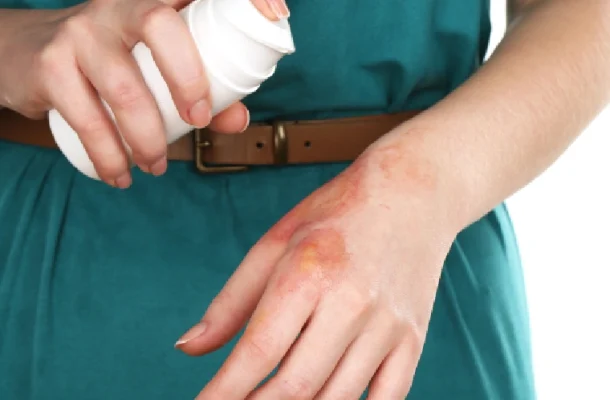
Itchy Encounters: Identifying and Treating Poison Ivy and Plant Dermatitis
Plant dermatitis, often caused by poison ivy, is a common environmental injury resulting from skin contact with plants that contain allergens. This condition can cause significant discomfort and irritation, but with proper treatment and precautions, it can be effectively managed. This article explores the causes, symptoms, and treatment options for plant dermatitis, specifically focusing on poison ivy exposure.
Understanding Plant Dermatitis: The Facts About Poison Ivy and Other Toxic Plants
1. Urushiol Oil
The primary cause of plant dermatitis from poison ivy, poison oak, and poison sumac is urushiol oil, which is present in all parts of the plant. Just a small amount of this oil can cause a reaction.
2. Common Plant Culprits
Poison ivy typically grows in wooded areas, along trails, or in gardens, while poison oak can be found in forests and fields. Poison sumac tends to grow in wet, swampy areas.
3. Symptoms Begin Quickly
Symptoms of plant dermatitis usually appear 12 to 48 hours after exposure to urushiol, with itching and redness being the first signs.
4. Spread of the Rash
The rash can spread to other parts of the body if the oil is transferred from clothes, tools, or pets that have been exposed to the plant.
5. Allergic Reaction
Over 85% of people are allergic to urushiol oil, and once you are sensitized, you will have a reaction every time you come into contact with it.
6. Severe Cases
In severe cases, plant dermatitis can cause swelling, blistering, and infection, especially if the rash is scratched.
7. Treatment Options
Common treatments for poison ivy include topical corticosteroids, calamine lotion, and oral antihistamines to reduce itching and inflammation.
8. Prevention is Key
Wearing protective clothing, using barrier creams, and properly washing off urushiol from your skin and belongings are the best ways to prevent plant dermatitis.
9. Not Contagious
Plant dermatitis from poison ivy is not contagious, meaning you cannot spread it to others through direct contact with the rash, only by coming into contact with urushiol oil.
10. Long-Term Sensitivity
Some people develop a stronger reaction to poison ivy with repeated exposure, making it even more important to avoid contact.
Avoiding Plant Dermatitis: A Guide to Poison Ivy and Toxic Plants
Plant dermatitis, commonly caused by poison ivy, poison oak, and poison sumac, can be a painful and irritating condition. The rash and discomfort stem from an allergic reaction to oils in these plants, specifically urushiol. While these plants are commonly found in wooded areas, gardens, and even urban landscapes, there are steps you can take to avoid exposure and minimize the risk of developing dermatitis.
The first step in avoiding plant dermatitis is to recognize the plants that cause the reaction. Understanding their appearance will help you steer clear of them:
• Poison Ivy: Typically has a three-leaf structure that is green but may turn red in the fall. It grows in a variety of environments, including wooded areas and gardens.
• Poison Oak: Its leaves resemble those of an oak tree, often in clusters of three, and it typically grows in dry, sunny areas.
• Poison Sumac: Found in wet, swampy areas, its leaves grow in pairs with a reddish stem, and it produces berries in the summer.
If you know you will be in areas where toxic plants are common, wear protective clothing. Long sleeves, pants, gloves, and boots are essential. The oils from poison ivy, oak, or sumac can easily stick to your skin, so the more skin you cover, the better. Ensure your clothing is thick and tightly woven to provide a barrier.
If you've been outdoors in an area where toxic plants are present, immediately wash your skin and clothes. Soap and water should be used to remove any urushiol oils from your body. It's important to also wash any gear (like gardening tools) and pets that may have come into contact with the oils to avoid spreading the rash.
Over-the-counter barrier creams can help prevent urushiol from contacting your skin. These creams act as a protective layer, reducing the chances of developing a rash. Be sure to apply these creams according to the instructions, especially if you're going to be in areas with a high concentration of toxic plants.
Never burn poison ivy, poison oak, or poison sumac. The oils can become airborne when burned, and inhaling them can cause severe respiratory issues or systemic reactions. Always properly dispose of plant material to avoid spreading the oils.
By following these tips and staying vigilant, you can reduce the risk of plant dermatitis caused by poison ivy, oak, and sumac. If you do come into contact with these plants and develop symptoms, seek medical advice promptly to treat and manage the rash before it worsens.
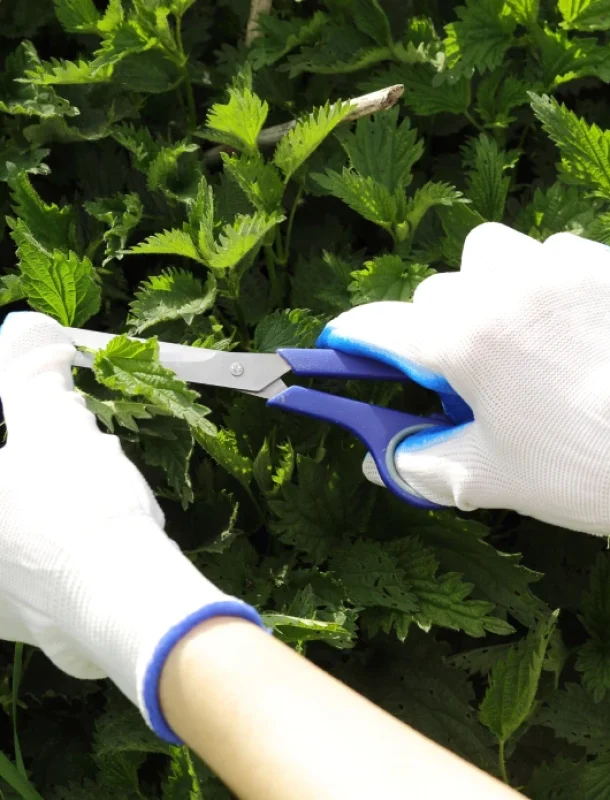
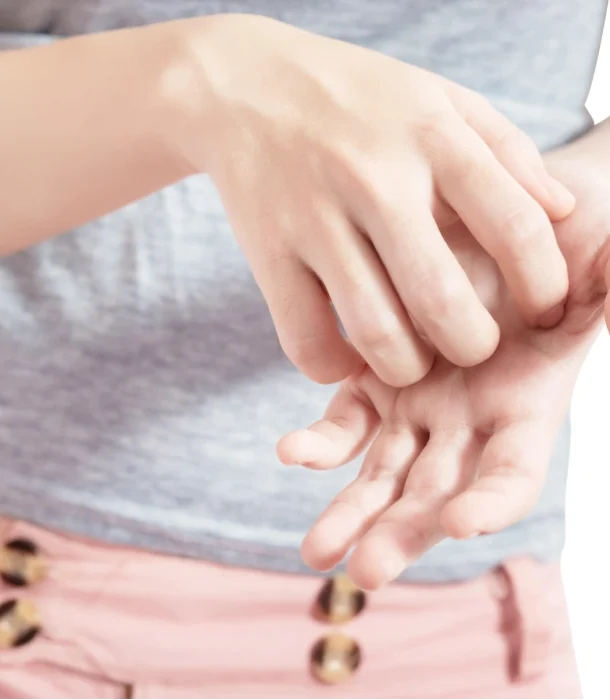
Plant Dermatitis: Overview and Treatment
What is Plant Dermatitis?
Plant dermatitis is a type of skin irritation or allergic reaction that occurs after contact with certain plants. This condition is most commonly caused by the exposure to plant oils, sap, or toxins that can trigger inflammation, redness, and discomfort. While the severity of the reaction can vary from person to person, plant dermatitis is typically harmless and can be treated effectively with proper care.
The most common culprits behind plant dermatitis are plants that contain toxic oils or resins, including:
• Poison Ivy: The plant contains an oil called urushiol, which is responsible for the allergic reaction.
• Poison Oak: Similar to poison ivy, poison oak also produces urushiol.
• Poison Sumac: Another plant that contains urushiol, leading to a similar reaction.
• Other Plants: Other plants like wild parsnip, giant hogweed, and stinging nettles can also cause skin reactions, though they tend to be less common.
When exposed to a plant that causes dermatitis, symptoms typically appear within a few hours to a few days, depending on the individual's sensitivity. Common symptoms of plant dermatitis include:
• Red, itchy rash: This is the most common sign of plant dermatitis.
• Blisters or bumps: Raised, fluid-filled blisters may develop in more severe cases.
• Swelling: The affected skin may become swollen and inflamed.
• Burning or stinging sensation: Some people experience a painful or tingling feeling in the affected area.
The rash typically appears in a linear or streaky pattern, often following the area where the plant made contact with the skin.
The severity of plant dermatitis can range from mild irritation to more severe symptoms. While most cases of plant dermatitis can be treated at home, there are situations where medical attention may be necessary. Here's how plant dermatitis is commonly treated:
- Wash the Area Immediately: As soon as possible after exposure to the plant, wash the affected area with soap and water to remove any residual oils, which can continue to cause a reaction even after the initial contact.
- Topical Corticosteroids: Over-the-counter hydrocortisone cream can help reduce inflammation and relieve itching. In more severe cases, a doctor may prescribe a stronger corticosteroid.
- Antihistamines: Oral antihistamines, like diphenhydramine (Benadryl), can help reduce itching and swelling. These are especially helpful if the rash is spreading.
- Cool Compresses: Applying a cool, damp cloth to the affected area can help soothe the skin and reduce inflammation.
- Oatmeal Baths: Soaking in a colloidal oatmeal bath (like Aveeno) can relieve itching and soothe irritated skin.
- Calamine Lotion: This can help dry out blisters and relieve itching, providing relief for mild cases of plant dermatitis.
- Avoid Scratching: Although it’s tempting, scratching the affected area can make the rash worse and increase the risk of infection.
In most cases, plant dermatitis is manageable with at-home treatments. However, you should seek medical attention if:
• The rash is widespread or severe.
• You experience significant swelling, especially on the face, eyes, or genitals.
• There are signs of infection, such as pus or increased redness.
• You have difficulty breathing, swelling of the throat, or other signs of a severe allergic reaction (anaphylaxis).
The best way to avoid plant dermatitis is by preventing contact with plants that cause skin reactions. Here are a few tips for reducing the risk:
• Know the plants: Learn to recognize poison ivy, poison oak, poison sumac, and other common plants that cause dermatitis.
• Wear protective clothing: When working outdoors, especially in areas where toxic plants may be present, wear long sleeves, long pants, gloves, and boots to reduce skin exposure.
• Wash clothes and tools: After spending time in areas with potential allergens, wash your clothes and clean tools that may have come into contact with plants.
• Use protective sprays: There are over-the-counter products available that can help protect the skin from exposure to poison ivy, oak, and sumac.
If you've come into contact with a plant and are experiencing symptoms of dermatitis, NextGen Walk-in Clinic & Urgent Care is here to help. Our medical team can assess your symptoms, provide immediate relief for itching and inflammation, and offer treatments like prescription-strength corticosteroids if necessary. We can also guide you on proper skin care and provide advice on avoiding future outbreaks.
Whether it’s a mild reaction or a more severe case, NextGen Walk-in Clinic & Urgent Care offers convenient and quick care to help you feel better faster. Don’t hesitate to visit us if you need professional treatment for plant dermatitis.
Understanding Poison Ivy and Other Culprits
Poison ivy is one of the most common plants that can cause allergic reactions in people. It contains a resin called urushiol, which can trigger skin irritation when it comes into contact with the skin. Here’s what you need to know about poison ivy:
• Characteristics: Poison ivy is easily identifiable by its distinctive three-leaf structure. The leaves are typically green but can change to shades of red, orange, or yellow in the fall. The plant may grow as a shrub, vine, or ground cover, and its leaves often have a glossy texture.
• Where It Grows: Poison ivy is widely found in wooded areas, along hiking trails, and in gardens throughout North America. It tends to thrive in areas that receive partial sunlight and moist soil, but it can also grow in drier, shaded spots. Be cautious when walking through forests, fields, or even backyards where the plant may be hidden among other foliage.
If you come into contact with poison ivy, you may develop a red, itchy rash, often accompanied by blisters. The reaction occurs within hours to a few days after exposure to the plant’s urushiol resin. The rash may appear in streaks or lines, following the path where the plant brushed against your skin. The rash can last for a few days to several weeks, depending on the severity of the reaction.
Besides poison ivy, there are other plants that can cause similar allergic reactions. Knowing what to look for can help you avoid exposure to these harmful plants.
Poison Oak
• Characteristics: Poison oak leaves resemble the leaves of the oak tree, with three to five leaflets. The edges of the leaves may be smooth or lobed, and they often have a rough texture. Like poison ivy, poison oak produces urushiol, which causes allergic reactions. The plant can grow as a shrub or vine and is commonly found in wooded areas and along trails.
• Where It Grows: Poison oak is primarily found in the western U.S. and parts of the southeastern U.S. It thrives in wooded areas, along roadsides, and in open fields. It’s often seen growing in sunny or partially shaded locations.
Exposure to poison oak can cause a rash similar to poison ivy, with itching, redness, swelling, and the development of blisters. The rash typically appears in streaks, where the skin made contact with the plant.
Poison Sumac
• Characteristics: Poison sumac grows as a shrub or small tree and has compound leaves that are arranged in pairs, with 7-13 leaflets per leaf. The leaves have a smooth texture and may turn red or yellow in the fall. Poison sumac also contains urushiol and causes a similar skin reaction as poison ivy and poison oak.
• Where It Grows: Poison sumac is typically found in wet, swampy areas, especially in the eastern U.S. It thrives in areas with high moisture content, such as marshes, bogs, and wetland areas. It is less common than poison ivy and poison oak but can still be found in certain regions.
The symptoms of poison sumac exposure are similar to those of poison ivy and poison oak. You may experience a red, itchy rash, swelling, and blisters, often in areas where your skin came into contact with the plant. The rash may appear in streaks or patches and can last for several weeks.
• Know the plants: Learn how to identify poison ivy, poison oak, and poison sumac. Familiarize yourself with their characteristics to avoid accidental contact.
• Wear protective clothing: When hiking or working outdoors in areas where these plants may be present, wear long sleeves, long pants, gloves, and boots to protect your skin from exposure.
• Wash immediately: If you come into contact with any of these plants, wash the affected area with soap and water as soon as possible to remove the urushiol resin.
• Clean tools and clothing: If you’ve been in an area with these plants, wash your clothing, shoes, and any tools you used to remove the resin and prevent future exposure.
If you come into contact with poison ivy, poison oak, or poison sumac, it’s important to seek treatment as soon as symptoms appear. Over-the-counter treatments like hydrocortisone cream, antihistamines, and cool compresses can help alleviate itching and inflammation. In more severe cases, medical attention may be required for prescription treatments, especially if the rash spreads to large areas of the body or if there are signs of infection.
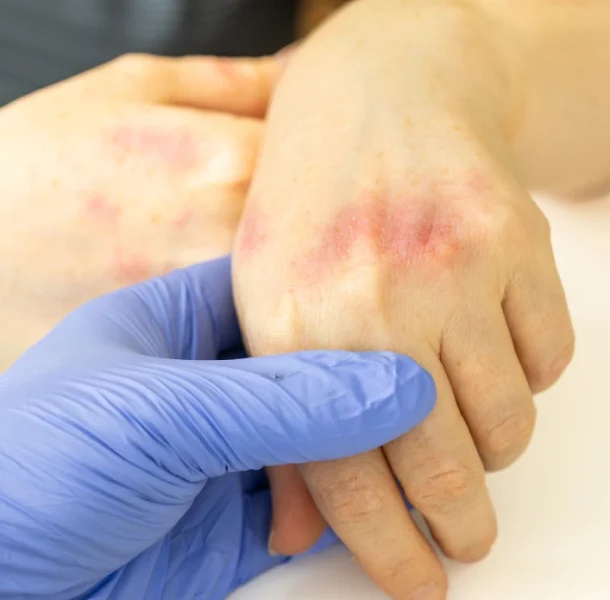

Symptoms of Plant Dermatitis from Poison Ivy
When exposed to poison ivy, the skin can react with a variety of symptoms due to the plant’s oil, urushiol, which triggers an allergic reaction. Symptoms can range from mild irritation to severe reactions, depending on the level of exposure and individual sensitivity.
• Itching, Redness, and Swelling: The earliest signs of plant dermatitis from poison ivy usually begin with intense itching, followed by redness and swelling at the site of contact. This happens as the body’s immune system reacts to the urushiol oil on the skin.
• Small Bumps or Blisters: After the initial irritation, small bumps or blisters may appear. These blisters can fill with fluid and can break open, leaking fluid that may contribute to the spread of the rash.
• Rash Spread: As the oil from poison ivy can linger on skin or clothing, the rash may spread beyond the initial contact area. This can happen if the oil spreads when scratched or if it transfers from clothing, pets, or tools that have come into contact with the plant.
• Swelling in the Face or Genital Area: In more severe cases, the rash may cause extensive swelling, especially around sensitive areas like the face or genitals. This swelling can be uncomfortable and, if left untreated, may result in complications.
• Difficulty Breathing or Swallowing: For some individuals with severe allergic reactions, the symptoms can extend beyond the skin, causing difficulty breathing or swallowing. This may indicate a systemic allergic reaction and requires immediate medical attention.
• Infection: The constant itching and scratching of the rash can lead to open blisters, which can easily become infected. Signs of infection may include increased redness, warmth, pus, or fever. It's important to resist the urge to scratch and keep the affected area clean to reduce the risk of infection.
Certain factors can increase your chances of developing a stronger or more severe allergic reaction to poison ivy. Understanding these risk factors can help you take precautions to avoid exposure.
• Touching any part of poison ivy—whether the leaves, stems, or roots—can result in an allergic reaction. Urushiol oil is present in all parts of the plant, and even a small amount can cause dermatitis. If you come into contact with poison ivy, it’s crucial to wash your skin with soap and water immediately to minimize the spread of the oil.
• Contact with Clothing, Tools, or Pets: If your clothing, tools, or pets come into contact with poison ivy, the oil can be transferred to your skin. This is why it’s important to wash any items that may have touched the plant and to check your pets for traces of the plant after being outdoors. Even indirect exposure can result in a reaction, especially if the oil is transferred to the skin later.
• Some individuals may not show a reaction after the first exposure but can develop an allergy after multiple exposures. Over time, repeated contact with urushiol can increase the body’s sensitivity to the plant, leading to stronger and more severe reactions upon future exposure.
• Stronger Reactions Upon Repeated Contact: Once a person becomes sensitized to urushiol, the immune system can overreact, causing more intense symptoms even with minimal exposure. For this reason, individuals with a history of poison ivy exposure may experience more severe rashes each time they come into contact with the plant.
Treatment Options for Poison Ivy Dermatitis
Poison ivy dermatitis can be uncomfortable, but with prompt and effective treatment, symptoms can be managed. The severity of the reaction may vary, and treatment depends on how far the condition has progressed. Here’s a guide to the treatment options for poison ivy dermatitis:
Clean the Skin:
The first step in treating poison ivy dermatitis is to wash the affected area with soap and water as soon as possible. This will help remove any remaining urushiol oil, which is the substance responsible for triggering the allergic reaction. The sooner you can wash off the oil, the less likely it is that a rash will develop.
Cool Compresses:
To soothe itching and reduce swelling, apply cool, damp cloths to the affected area. This will help calm the skin and bring temporary relief from discomfort. Be sure to avoid hot water, as it may make the rash worse.
Avoid Scratching:
While the itching can be intense, it's essential to resist the urge to scratch. Scratching can introduce bacteria to the open skin, potentially leading to infection, which can worsen the condition and prolong healing time.
Topical Corticosteroids:
Hydrocortisone creams are available over the counter and can help reduce inflammation and itching. These creams are effective in mild to moderate cases of poison ivy dermatitis and can be applied directly to the affected area for relief.
Calamine Lotion:
Calamine lotion is a well-known remedy for poison ivy rashes. It has soothing properties that can help dry out blisters and alleviate itching. Applying this lotion to the rash provides cooling relief and promotes the healing process.
Antihistamines:
Oral antihistamines, such as diphenhydramine (Benadryl), can help reduce itching and may also help you sleep if symptoms are particularly severe at night. Be sure to follow the recommended dosage and avoid overuse.
While many cases of poison ivy dermatitis can be managed at home, there are certain situations where you should seek medical care:
• Large Areas Affected: If the rash covers a large portion of your body or affects sensitive areas like the eyes, mouth, or genitals, it’s important to seek medical attention immediately.
• Worsening Symptoms: If symptoms worsen despite following home treatments, or if the rash doesn’t improve after a few days, it may be necessary to seek professional care.
• Signs of Infection: If you notice increased redness, warmth, or pus coming from the blisters, this could indicate an infection. Infections can develop from scratching and must be treated promptly to avoid complications.
At NextGen Walk-in Clinic & Urgent Care, we understand the discomfort caused by poison ivy dermatitis, and we’re here to provide you with fast, effective care. Here’s how we can assist:
Fast and Accurate Diagnosis:
Our medical professionals can quickly assess your rash and determine whether it’s poison ivy or another type of plant dermatitis. This ensures that you receive the appropriate treatment for your condition.
Prescription Medications:
For more severe cases, we can prescribe stronger corticosteroids, oral antihistamines, or antibiotics if the rash becomes infected. Our goal is to ensure your comfort and prevent complications, so we will provide the necessary medications to help you recover.
IV Hydration and Supportive Care:
If your allergic reaction is particularly severe, we offer IV fluids for hydration and supportive care to monitor your condition. This is especially helpful if the symptoms are extensive and require additional medical support.
Preventative Advice and Education:
We provide guidance on how to avoid future exposure to poison ivy, including tips on recognizing the plant, using protective clothing, and removing urushiol oil from your skin and belongings. Our education helps you stay safe and avoid similar incidents in the future.
Convenient Walk-In Care:
Whether you’ve just come into contact with poison ivy or if your symptoms have worsened, NextGen Walk-in Clinic & Urgent Care is here to offer immediate relief. You don’t need an appointment—just walk in, and we’ll take care of you promptly.
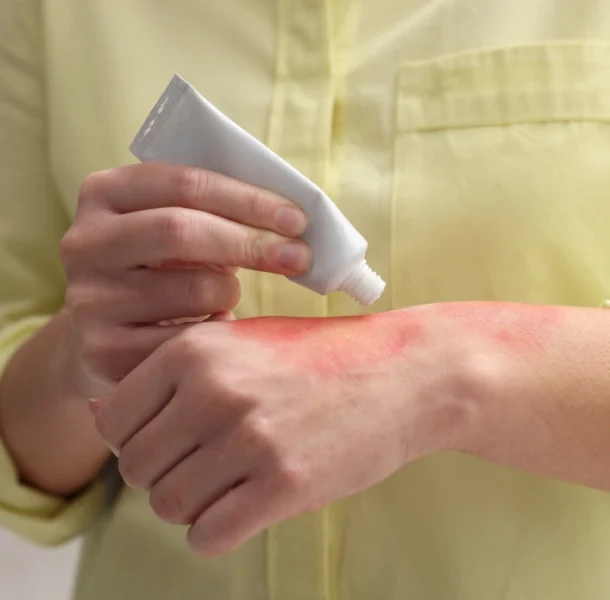

Prevention Tips for Plant Dermatitis
Plant dermatitis, caused by exposure to toxic plants like poison ivy, poison oak, and poison sumac, can be uncomfortable and challenging to manage. However, by taking some preventative measures, you can significantly reduce the risk of developing plant dermatitis. Below are some effective tips to help you avoid exposure to these harmful plants:
The first step in preventing plant dermatitis is learning to recognize the plants that can cause it. Poison ivy, poison oak, and poison sumac are the most common culprits. Here’s what to look out for:
• Poison Ivy: Typically has a three-leaf structure. Leaves are usually green, but they can turn red in the fall. It’s found in wooded areas, gardens, and along trails.
• Poison Oak: Leaves resemble oak leaves and often grow in clusters of three. It can be found in wooded areas, especially in the western U.S.
• Poison Sumac: Grows in wet, swampy areas and has leaves arranged in pairs, often with a reddish tint.
By familiarizing yourself with these plants and where they grow, you can avoid accidental contact and reduce the likelihood of developing dermatitis.
If you need to enter areas where poison ivy, poison oak, or poison sumac are present, taking the right precautions can prevent exposure:
• Long Sleeves and Pants: Wear long sleeves and pants made of thick fabric to cover exposed skin. This acts as a barrier between your skin and the toxic oils found in these plants.
• Gloves and Boots: Wear gloves when handling plants and boots when walking through areas where toxic plants may grow. This will help protect your hands and feet from direct contact with the oils.
• Consider Wearing a Hat: In areas with overgrown vegetation, wearing a hat may help prevent exposure to your face and neck.
These simple protective measures will significantly reduce your risk of coming into contact with plant oils.
Even if you take precautions, it’s possible to come into contact with poison ivy or other toxic plants without realizing it. After spending time outdoors, it’s essential to clean yourself and your belongings properly to prevent spreading the oils:
• Wash Your Skin Immediately: As soon as you’ve been outdoors, wash your skin with soap and water to remove any traces of plant oil (urushiol) that may have come into contact with your skin.
• Clean Your Clothes and Tools: Urushiol can stick to clothing, tools, and other items, so make sure to wash them thoroughly to avoid spreading the oil. Washing clothes in hot water with detergent is effective at removing the oils.
• Check Your Pets: Pets can carry urushiol on their fur if they’ve been in contact with toxic plants. Be sure to wash them as well, especially if they’ve been outdoors in areas with poison ivy or poison oak.
Proper cleaning reduces the risk of unknowingly transferring plant oils to other surfaces or people.
There are barrier creams available over-the-counter that can help protect your skin from the toxic oils found in poison ivy, poison oak, and poison sumac. These creams create a protective layer on your skin, preventing the oils from penetrating and causing an allergic reaction. Some common barrier creams include:
• IvyBlock: This is a popular product that helps protect against poison ivy, oak, and sumac.
• Zanfel: Although not a preventive cream, Zanfel can be used to break down urushiol oils if you have been exposed.
Be sure to apply these creams to exposed areas of your skin before you go outdoors in areas where toxic plants may be present. They can provide an added layer of protection against accidental exposure.
Customer Reviews for NextGen Walk-in Clinic & Urgent Care

Patricia S.
Lorem ipsum dolor sit amet, consectetur adipiscing elit. Praesent tincidunt tortor at tempor auctor. Fusce venenatis euismod eros eget ullamcorper. Aliquam fermentum dignissim metus vel maximus. Integer quis tempor sem. Mauris placerat fermentum ornare. Nam vestibulum hendrerit purus eget auctor. Aliquam erat volutpat.

Mark M.
Lorem ipsum dolor sit amet, consectetur adipiscing elit. Praesent tincidunt tortor at tempor auctor. Fusce venenatis euismod eros eget ullamcorper. Aliquam fermentum dignissim metus vel maximus. Integer quis tempor sem. Mauris placerat fermentum ornare. Nam vestibulum hendrerit purus eget auctor. Aliquam erat volutpat.

Christine M.
Lorem ipsum dolor sit amet, consectetur adipiscing elit. Praesent tincidunt tortor at tempor auctor. Fusce venenatis euismod eros eget ullamcorper. Aliquam fermentum dignissim metus vel maximus. Integer quis tempor sem. Mauris placerat fermentum ornare. Nam vestibulum hendrerit purus eget auctor. Aliquam erat volutpat.
Do You Have any Query?
Frequently Asked Questions (FAQs) About Poison Ivy
Lorem Ipsum is simply dummy text of the printing and typesetting industry. Lorem Ipsum has been the industry's standard dummy text ever since the 1500s, when an unknown printer took a galley of type and scrambled it to make a type specimen book. It has survived not only five centuries, but also the leap into electronic typesetting, remaining essentially unchanged. It was popularised in the 1960s with the release of Letraset sheets containing Lorem Ipsum passages, and more recently with desktop publishing software like Aldus PageMaker including versions of Lorem Ipsum.
Lorem Ipsum is simply dummy text of the printing and typesetting industry. Lorem Ipsum has been the industry's standard dummy text ever since the 1500s, when an unknown printer took a galley of type and scrambled it to make a type specimen book. It has survived not only five centuries, but also the leap into electronic typesetting, remaining essentially unchanged. It was popularised in the 1960s with the release of Letraset sheets containing Lorem Ipsum passages, and more recently with desktop publishing software like Aldus PageMaker including versions of Lorem Ipsum.
Lorem Ipsum is simply dummy text of the printing and typesetting industry. Lorem Ipsum has been the industry's standard dummy text ever since the 1500s, when an unknown printer took a galley of type and scrambled it to make a type specimen book. It has survived not only five centuries, but also the leap into electronic typesetting, remaining essentially unchanged. It was popularised in the 1960s with the release of Letraset sheets containing Lorem Ipsum passages, and more recently with desktop publishing software like Aldus PageMaker including versions of Lorem Ipsum.
Lorem Ipsum is simply dummy text of the printing and typesetting industry. Lorem Ipsum has been the industry's standard dummy text ever since the 1500s, when an unknown printer took a galley of type and scrambled it to make a type specimen book. It has survived not only five centuries, but also the leap into electronic typesetting, remaining essentially unchanged. It was popularised in the 1960s with the release of Letraset sheets containing Lorem Ipsum passages, and more recently with desktop publishing software like Aldus PageMaker including versions of Lorem Ipsum.
Lorem Ipsum is simply dummy text of the printing and typesetting industry. Lorem Ipsum has been the industry's standard dummy text ever since the 1500s, when an unknown printer took a galley of type and scrambled it to make a type specimen book. It has survived not only five centuries, but also the leap into electronic typesetting, remaining essentially unchanged. It was popularised in the 1960s with the release of Letraset sheets containing Lorem Ipsum passages, and more recently with desktop publishing software like Aldus PageMaker including versions of Lorem Ipsum.
Lorem Ipsum is simply dummy text of the printing and typesetting industry. Lorem Ipsum has been the industry's standard dummy text ever since the 1500s, when an unknown printer took a galley of type and scrambled it to make a type specimen book. It has survived not only five centuries, but also the leap into electronic typesetting, remaining essentially unchanged. It was popularised in the 1960s with the release of Letraset sheets containing Lorem Ipsum passages, and more recently with desktop publishing software like Aldus PageMaker including versions of Lorem Ipsum.
Lorem Ipsum is simply dummy text of the printing and typesetting industry. Lorem Ipsum has been the industry's standard dummy text ever since the 1500s, when an unknown printer took a galley of type and scrambled it to make a type specimen book. It has survived not only five centuries, but also the leap into electronic typesetting, remaining essentially unchanged. It was popularised in the 1960s with the release of Letraset sheets containing Lorem Ipsum passages, and more recently with desktop publishing software like Aldus PageMaker including versions of Lorem Ipsum.
Lorem Ipsum is simply dummy text of the printing and typesetting industry. Lorem Ipsum has been the industry's standard dummy text ever since the 1500s, when an unknown printer took a galley of type and scrambled it to make a type specimen book. It has survived not only five centuries, but also the leap into electronic typesetting, remaining essentially unchanged. It was popularised in the 1960s with the release of Letraset sheets containing Lorem Ipsum passages, and more recently with desktop publishing software like Aldus PageMaker including versions of Lorem Ipsum.
Protect Your Skin from Poison Ivy and Other Toxic Plants
By recognizing toxic plants like poison ivy, poison oak, and poison sumac, taking protective measures, and cleaning up properly afterward, you can greatly reduce your risk of developing plant dermatitis. Preventive steps such as wearing protective clothing and using barrier creams can also provide valuable protection against exposure. However, if you do experience symptoms, prompt treatment is key to managing the condition and preventing complications.
If you’ve been exposed to poison ivy or another toxic plant and need medical attention, NextGen Walk-in Clinic & Urgent Care is here to help. Visit us today for fast, effective care and get back on your feet. Don’t wait – take action now!

